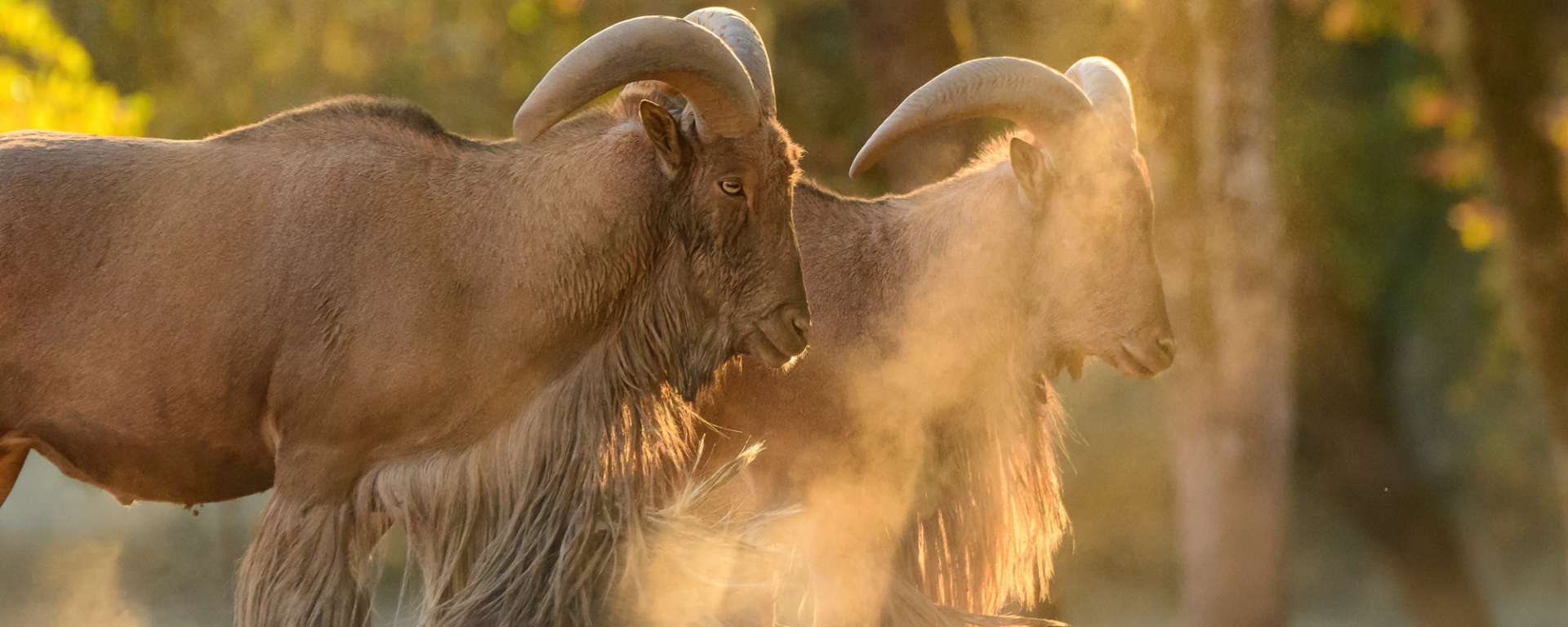Safari Spotlight: Aoudad
Posted in: Safari Spotlight
Tags: aoudad, barbary sheep
The aoudad, or barbary sheep, is one of the more unusual hoofed animals found at Safari West. Their latin name, Ammotragus lervia roughly translates as sand-goat and that pretty accurately describes the creature. The aoudad (OW-dad or aOO-dad) is the only sheep species housed in our collection and one of very few native to Africa. In appearance, the aoudad looks very much like the North American bighorn sheep with a stocky brown-furred body and thick backward curling horns. Both males and females present with these large horns although they are significantly larger on the rams.
While both genders have tufts of longer hair sprouting from their throats, these are also exaggerated on the rams. The male aoudads grow long bushy beards that extend down onto their chests and forelegs once they reach maturity. Our biggest males look a bit like they’re sporting 1970’s era bell-bottoms as they move up and down the steep hillsides and ravines of Safari West. Within the population, the males are significantly larger than the females (up to twice the body mass in fact) and have a remarkable ability to appear out of nowhere and then rapidly disappear once spotted.
Aoudad was once found throughout much of North Africa. They specialize in rugged mountainous areas ranging from true deserts to semi-deserts to open forests. They can survive without access to standing water as long as they have an adequate moisture-containing food supply and they are highly adaptable in terms of the plant life they will consume. In spite of these beneficial adaptations, the aoudad have suffered a steep and ongoing population decline over the last several centuries. Today there remain scattered and fragmentary populations in many nations including Egypt, Chad, Tunisia, and Niger although the last major strongholds of the species seem to be found in Morocco and Algeria.
It should be pointed out that the countries mentioned above are within the aoudads native range. As it turns out, aoudad have become something of an invasive species and there are now wild populations of this large African sheep in much of the American southwest as well as in parts of Spain. One of the factors that has led to aoudad decline in Africa also explains their healthy populations overseas; hunting. Historically, the aoudad had few predators, essentially leopards, lions, and caracals, but in modern history the only consistent threats they face come from humans. Aoudad have long been hunted for food by many north African cultures, but in recent centuries, the appeal of those large curving horns has made the animals the target of trophy hunters as well. Many countries with native populations of aoudad have instituted strict regulations in an effort to preserve the viability of their remaining herds.
The International Union for the Conservation of Nature (IUCN) estimates somewhere between 5,000 and 10,000 remaining wild aoudad and classify the species as vulnerable (one step above endangered) and declining. It is important to note that the IUCN makes explicit that their estimates are based on wild populations in the animals’ historic range. They do not account for any of the introduced animals now thriving in the southwestern US, northern Mexico, Spain, or the Canary Islands. These populations, though introduced by humans and implicitly invasive, are flourishing. One estimate places the Texas population alone at around 25,000 animals.
While not an unprecedented situation, this bizarre contradiction between declining native populations and burgeoning introduced populations highlights the extreme impacts human development and the game hunting industry can have on a species (and its associated ecosystem). The apocryphal story of aoudad in America starts with American soldiers in the African theater during World War II. Some soldiers encountered wild aoudad and noted the potential for the species as a game animal. During the post-war 40’s and 50’s, some aoudad were shipped to the US. Avid mountain climbers and talented jumpers, aoudad quickly demonstrated the ability to clamber over or jump a six or seven-foot fence and before long wild populations were exploding and competing with (possibly out-competing) our native bighorns.
The aoudad at Safari West are reclusive animals and among the more challenging individuals to find on tour. When you come visit, make sure to keep your eyes peeled any time your truck rolls past a steep ravine or especially wooded hillside. On more than one occasion these animals have surprised guests and guides alike by appearing not only on the steepest of cliff-sides but even up in the branches of some of our sturdier old oaks!


